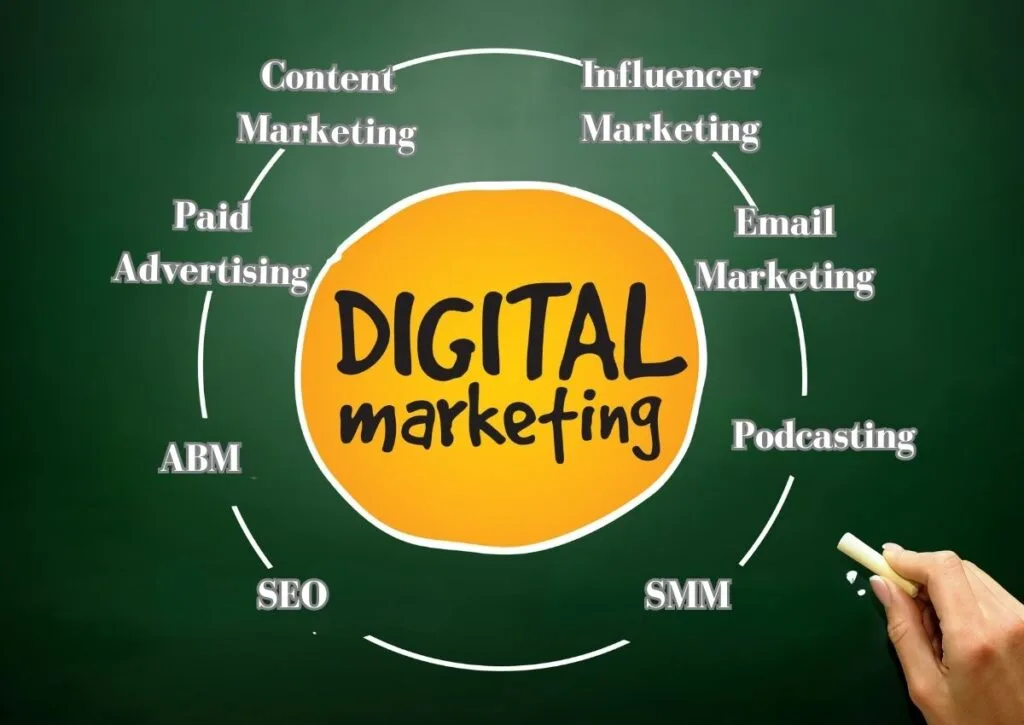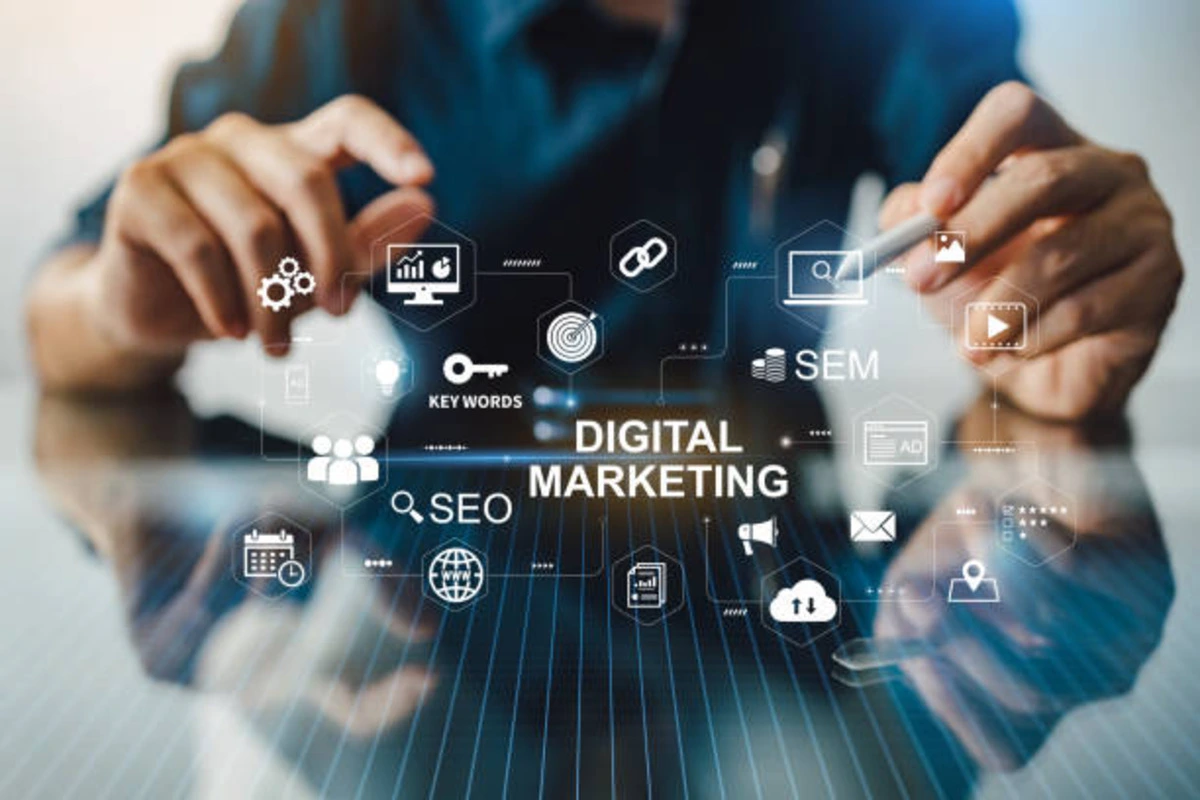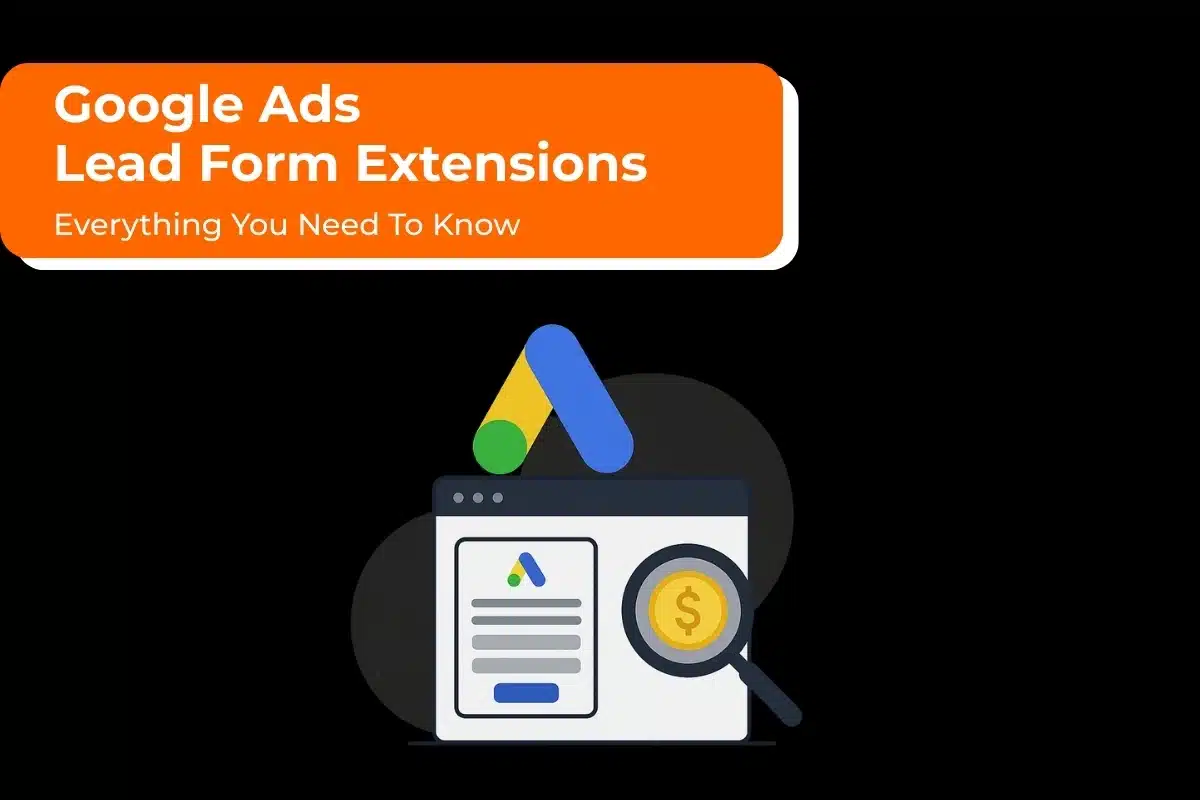The whole world has gone digital. Almost every person or company with access to the Internet is online. This is what it means to live in our Internet era, where you can use such media technology for an audience coming up with new creative demands now more than ever! And if you want to reach out, move with the changing times, and create good campaigns—a well-structured Digital Marketing Strategy will get you there.
In the online world, where one change follows another and is so sudden that you could be left behind in a blink–your strategy must adapt immediately. Therefore, a pertinent, feasible, and agile digital marketing strategy is what you need. We have assembled this guide to help you formulate a digital marketing plan that can serve as a roadmap to help you understand what works, what has been missed out, and how to reach your goals.
What is a Digital Marketing Strategy?
It’s the pulse that connects your online business objectives with offline efforts to meet your goals. Furthermore, marketing no longer relies on numbers and costs alone—it has to incorporate insights from end-user data. Observe who is selling and what they are selling, how they are sold in their market, and how those with more consumerism and strategic digital marketing strategies are growing their businesses.
A digital marketing strategy focuses on all aspects–paid, owned, and earned media. However, only a well-crafted and articulated strategy will work.
Therefore, it is important to set your goals first. These goals may include enhancing brand visibility, generating sales leads, guiding prospects through the sale funnels, or increasing the customer base. Once you have set your objectives, your strategy will now revolve around these objectives.
Thus, a digital marketing strategy systematically uses online channels to achieve pre-set objectives to add overall success and improve business yields.
Digital marketing is more than running online ads or uploading a video to your social media platform. You have to use certain communication tactics and campaigns to make it effective.
Read Also:- How Digital Marketing Helps in Business Growth in 2024?
Marketing Strategy vs. Marketing Tactic vs. Marketing Campaign
A well-defined compilation of decisions that specify what you will (and will not) do is outlined in a marketing plan. Combined, these decisions provide your marketing with a distinct strategic orientation, defined as your marketing strategy.
Alternatively, the specific actions you take to carry out your marketing plan are known as marketing tactics.
On the other hand, marketing campaigns use interactive marketing tactics like video conferencing, demonstrations, and other strategies in addition to advertising.
For instance, a Facebook ad (marketing) campaign targeting particular buyer personas is one of the hundreds of possible tactics in a digital marketing strategy. Other strategies include blogging to elevate website presence, posting carefully chosen material on social media, and employing backlinks to improve search engine ranking. It is possible to have tactics within tactics; for example, a website or brand refresh consists of several minor tactics that work together to improve the end product. However, a single marketing plan covers all of these promotional tactics.
A business objective is what you expect to accomplish after reaching a specified goal, but a marketing goal is where you expressly want to go. Your tactics are the tools you employ via marketing campaigns to get where you’re going, and your marketing strategy is your map.
Make sure that every marketing tactic you use in your marketing campaign fits under the general umbrella of your marketing strategy and advances you a step closer to your objective.
Types of Digital Marketing Strategy

One of the most crucial strategic efforts for businesses nowadays is digital marketing. Since buyers like to be informed about their items, many individuals use the Internet to research companies and products. Using various digital marketing methods, you may contact your audience through their current platforms to promote your brand and products. So, let’s start by defining digital marketing before learning about its different forms.
1. Content Marketing
Informational and helpful content such as blogs, articles, how-to videos, and other instructional resources is called content marketing. This type of advertising allows you to communicate with your audience and respond to their problems. It can also help to generate leads or complete transactions. Regular publishing of content should take the intended audience into account. It is hoped that by generating original, top-quality content, your company can gain both attention and credibility in the market. Whatever the latest advancements in your industry, you want your audience to go there first whenever something new comes along.
Advantages of Content Marketing
- There is no extra cost attached to it.
- Content may vary with the modus operandi. However, it is still the digital marketer’s most important tool. It informs, entertains, and inspires the audience as it builds your brand.
- It supports all other digital marketing strategies and gives them the impetus for success.
Read Also:- The Future of SEO Content Writing
2. Paid Advertising
As the name suggests, paid advertising is an online marketing tactic that one has to pay for. Pay-per-click (PPC), Google Ads, Facebook Ads, LinkedIn Ads, programmatic advertising, Google Display, X Ads, Google and Facebook retargeting, and more are a few examples of paid advertisements.
Paid advertisements are incredibly effective because they allow marketers to target specific populations with highly targeted ads.
The advertising networks usually use two different ways to bill users:
Pay Per Click (PPC): Each time an advertisement is clicked, the advertiser gets charged.
Cost Per 1000 Views (CPM): One is charged a cost per thousand impressions on a webpage.
Types of Paid Advertising
- Search Advertising
- Social Media Advertising
- Banner and Display Advertising
- Google Display Advertising
- YouTube / Video Advertisements
Advantages of Paid Advertising
- It helps brands rank faster online.
- It saves time.
- Paid ad is the only option if the organic reach isn’t working.
- It’s affordable and measurable.
- Targeting is precise and detailed
- Show the target audience what they are looking for to keep them interested.
3. Account-Based Marketing (ABM)
As a powerful B2B marketing strategy, it focuses resources on a group of target accounts within a market. Specifically, it bases the marketing message on each account’s unique characteristics and requirements, utilizing tailored campaigns to engage each one.
ABM tactics also look at marketing from a wider perspective than merely lead generation. Getting the most out of your biggest accounts requires marketing to current customers in a way that promotes cross-selling and upselling. Due to this, 92% of businesses with established ABM programs claim that it generates higher returns on investment than any other marketing strategy.
Advantages of ABM
- Enhances client interactions from the point of sale through to retention.
- Promotes collaboration between sales and marketing departments throughout the buyer journey
- Decreases the “opportunity to close” period by one month and increases income by 8–10%.
- Only a few accounts with the highest chance of closing sales receive time and resources.
4. Search Engine Optimization (SEO)
The process of writing content infused with targeted keywords so that search engines, such as Google, will rank your website highly on the search engine results page (SERP) is known as search engine optimization or SEO.
Google employs algorithms to determine the degree of relevancy between your website and the terms a person is searching for. Because these algorithms change often, SEO tactics must be modified to be relevant.
Done rightly, SEO activities naturally push traffic to your website and catapult it into the top spot on the SERP (search engine results page).
Advantages of SEO
- It helps in raising brand awareness.
- It is more cost-effective.
5. Social Media Marketing (SMM)
Social media platforms are used as digital marketing tools. It is most often utilized in social media marketing to advertise. You could still attract customers on sites like Facebook if you don’t want to advertise. You set up a company’s profile on any social networking medium, pushing out sales information or new goods news. Which social media site will attract the kind of audience you want?
Pew Research, for instance, states that Facebook is the most effective platform for reaching individuals 65 and older, whereas Instagram is ideal for targeting people between the ages of 25 and 29.
Advantages of Social Media Marketing
- Its conversion rates are good.
- The efforts grow exponentially as more people like, comment on, and share the brand’s offerings.
- If needed, you can run an advertisement campaign targeting specific customer groups on platforms like Facebook and Instagram.
6. Influencer Marketing
You can reach a larger audience by partnering with an influencer to work with their existing followers. Find an influencer popular in your industry to form a successful business partnership. An influencer can share content that leads back to your site and helps sell your products and services.
Advantages of Influencer Marketing
- An influencer provides instant access to existing followers. You don’t have to spend the time and energy to build your own.
- Associating with a widely known person can bring you real customers and fans.
7. Podcasting (Audio Marketing)
With the inclusion of podcasts and smart home assistants such as Google Home and Amazon Alexa, audio marketing is much more diverse than anyone has ever thought. Podcast listening is becoming more and more popular, taking away radio listeners.
If you want to be successful in audio marketing, you must understand your audience’s habits. Additionally, consider what people could do between listening to the audio of your speech. In this way, your audio marketing may become a major channel for corporate sales.
Advantages of Podcasting
- Audio marketing provides an easy-to-use platform for on-demand content.
- It is more affordable than creating a video.
8. Email Marketing
Request the people who visit your website or social media pages to join your email list. But it must be done with their permission to use it to improve your sales. Email marketing is often underrated. According to Lyfe Marketing, for every dollar that is invested in advertising, $40 in revenue is generated. Most importantly, it is the fact that this digital marketing channel benefits your audience. Offering them deals and special discounts can help improve brand loyalty and increase sales and customer base.
Advantages of Email Marketing
- This type of digital marketing does not depend on what search engine you’re in.
- If you keep in regular touch with your e-mail list, you can build relationships and increase the chances of them buying your product or using your service.
9. Video Marketing
Short, snappy videos draw in viewers more quickly than text. Live or pre-recorded video content is a dependable digital marketing choice, whether instructive or amusing. Currently, over 2 billion individuals use YouTube monthly to search for anything. Reaching out to new clients is a great opportunity, and using video marketing techniques produces results through the marketing funnel.
On average, 80% of the audience prefers researching items and reading reviews using search engines or online videos. It is done before a purchase by 55% of the prospects].
Advantages of Video Marketing
- Videos may efficiently disseminate your message by establishing an emotional connection with the audience.
- People remember them better than words or pictures.
- Video content is being promoted on Facebook, Instagram, and LinkedIn to increase reach and engagement and rank higher in search results.
10. Online (and in-person) Events
Events that occur virtually include social interaction since they happen virtually. When you organize a virtual event, attendees interact with you online in real time. On the other hand, in-person activities foster a more immediate and personal relationship between the host and guests.
Advantages of Online (and in-person) events
Virtual/Online
- A much more affordable option.
- Easily accessible.
- Attains a broader audience more effortlessly.
- Attendees can interact more extensively and capture more interest, thus increasing the effectiveness of these events greatly.
In-Person
- Connect, engage, and share experiences with the participants.
- A more personalized experience means you will understand the participants better. This is a great starting point for building relationships.
11. Chatbot and Live Chat Marketing
Chatbots and live chat can be installed anywhere—on your website or social media via messengers or other websites. Chatbots provide smart information. Additionally, in any and every situation, the chatbot has a preset scenario and answer. If need be, a human representative can engage in live chat directly with customers to provide a more individualized service. Moreover, live chat leads the sales process.
Advantages of Chatbot & Live Chat Marketing
- May be employed to increase sales. It only needs to be set up for a wide range of customers. It operates 24 hours daily, 365 days a year.
- Live chat can help boost customer loyalty. It saves on support expenses, reduces cart abandonment situations, and increases client satisfaction and interaction. This will improve your chances of finding a potential lead.
12. Earned Media
When one person or organization doesn’t have to pay to be mentioned by others–this is called earned media. It can be a mention on social media, an appearance on television shows, or a profile in a magazine.
Brands are gaining popularity through earned media because an outside consumer-trusted source recommends it. This is similar to a friend’s recommending your brand. Remember that customers tend to trust the brand when recommended through other channels.
Advantages of Earned Media
- It raises public awareness and enhances the visibility of the brand.
- It is an excellent method for breaking into the right market.
- Customers are more likely to come back.
- It is a less expensive alternative.
13. Websites
Websites have long been a marketing tool for businesses to promote their products and brands and stay in touch with their customers. Not only are their products shown online, but they have even become a way to provide the usefulness of what is offered to customers. Websites represent a way to contact the right people quickly and effectively.
Advantages of a Website
- Improves SEO and your virtual presence.
- Makes Your Products Available Globally
- Enhances direct customer interaction.
- It is a less costly way to publicize a business. The more leads you have, the greater your chance of selling your products.
Read Also:- Common Web Design Mistakes that Negatively Impact Your SEO
14. Online Reviews
Consumer reviews are very influential in the buying process. Moreover, online consumer reviews are deeply connected with your digital marketing strategy. Your brand’s reputation, search engine ranking, and business development depend on them.
Advantages of Online Reviews
- It helps the customer, considering your service or product, believe in you.
- Bring your website to the top of search engine rankings.
- Over time, higher clickthrough rates at your site–concerning your competition–will certainly offset the above costs. In effect, you get more for less.
15. Listings Management
This means having your company’s data everywhere on the internet kept up to date. Your information can be seen correctly and not garbled when you do that. Since potential clients base their judgment on sound, consistent business information, such as whether a company is dependable, this is important.
This is important because potential clients make decisions based on reliable and consistent business information.
With Google My Business (GMB) businesses can update their location, hours, contact details, or even respond to reviews and manage how they appear on Google. This means there’s a better likelihood your company will be close to the top of the search results of potential customers who Google your business or compare a business model similar to yours. Multiple web platforms maintain business data consistently and precisely, making the following much easier.
Advantages of Listings Management
- It makes your brand more likely to appear in local search results.
- Gains the trust of prospective clients.
- It helps reach a larger audience with your brand to boost visibility.
- Set the brand apart from its competitors.
- Acknowledges the company as a trustworthy brand in its industry.
How to Develop a Digital Marketing Strategy?

1. Build buyer personas
Buyer personas allow you to organize better plans tailored to a particular group. For instance, market to segments. Through customer type and behavioral research, you can easily plan your marketing. This will help you cater to your customer’s needs so that they feel valued.
Example: To illustrate the point, a fitness brand could focus on one of its buyer personas: “Active Ann.”
Active Ann lives a healthy lifestyle between 25-35 years old. In addition, she has had an interest in home workouts and organic foods.
2. Set Goals and Objectives
Establish SMART objectives that align with the client’s immediate and long-term goals.
Example: To enhance profits by $200,000 by year-end, strategic objectives include boosting website traffic by 20% and elevating sales by 15%. Additionally, aiming for a 10% rise in followers and actively engaging them through social media channels will be pivotal.
3. Audit Your Existing Digital Channels
If you want to improve the performance of your digital network, analyze the strengths and weaknesses of your existing digital platforms, like websites, social media content, and email campaigns.
For instance, When you perform an analysis, you notice that you get the highest number of visits from people searching for you on search engines. You then put your money, time, and efforts into SEO.
4. Decide Which Digital Marketing Tools You Want to Invest in
Try using your brand’s best digital assets, tools, and channels. Your website, blog posts, social network accounts, word-of-mouth marketing, native advertising, Google Ads, sponsored advertising, etc.
5. Establish a Marketing Budget
You should establish a budget for advertising and content production. For example, if advertising gets just $40,000, then $10,000 might just as well be spent on developing relevant content.
6. Focus on Content
Distribution will vary depending on what type of content you have. However, If people can’t see your brand, how will they know of it? Put it out there. Through blogs and posts, videos, and articles regularly, put fresh, original content in the spotlight.
7. Decide How to Distribute Your Content
Using paid channels such as Google Ads, social media, and even Micro-influencers, you can reach a much larger audience — all at increased website traffic! But if not used carefully, it can also be costly and ineffective. A little bit of rounding-edge social media channels can also increase your traffic. Email marketing campaigns and SEO are also useful for increasing site traffic. But to build an audience of your own takes time and effort.
Make a strategy that balances between paid and earned channels. It needs to fit the character and monetary bounds of your brand. Reach out to your partners and influencers. Just make sure that the partners you pick make sense for your audience and are consistent with your brand. Creating a two-way benefit in the long run is a profitable collaboration for both sides. With the limited resources of time and energy, producing original material demands a great investment in these areas. Therefore, it is necessary to repurpose and recycle your current content into other formats and channels. A social media post might become an email newsletter, a podcast a blog article. Also, a blog article will turn into a video. This ensures that your content reaches a wider audience and saves time and effort.
8. Explore and Implement Automation
We now have new software and technology that is being integrated into those strategies of digital marketing. Consequently, a form of marketing automation becomes harder to resist. Moreover, many good marketing automation tools today can go a long way to help your digital marketing strategy. For instance, making it easy to do things like lead generation, content marketing, or email marketing on a smaller budget.
You can also easily find marketing automation tools that integrate with the sales CRM at your company, thus improving the sales process generally.
Please ensure your company introduces automated lead generation into your digital marketing plan to join the trend.
Examine some marketing automation platforms. Businesses can use automated processes for lead nurturing, content distribution, and email marketing.
9. Measure Results & KPIs
Check it regularly. There are two reasons you need to know if your digital marketing plan is effective. Obtaining straightforward feedback can be difficult in a fast-paced, high-pressure environment. Therefore, systematic, ongoing evaluation and upgrades are recommended to create a balance. Dedicated teams may be assembled to inspect metrics, identify areas of improvement, and learn from past mistakes. Adopt a mindset that likes constant change while being adaptable and capable of creative answers. Use feedback loops to conduct regular data analysis and look for possible solutions.
Wrapping it Up
Digital marketing strategies can make a great difference for a business, increasing your audience base from a local to a global fan base!
But it’s not as simple as that because not every digital marketing strategy works. There is a dire need for workable plans, a competitive budget, and experienced professionals to execute them.
In a word, sales, profits, awareness, and customer loyalty are achievable through digital marketing!
If you need an effective digital marketing strategy, contact Website Pandas, a reputed Digital Marketing Agency!






